Basis of Identification, Type of Syngenetic Assemblage, and Pattern of Development of Coal and Oil Shale in the Tanshan Area of the Eastern Liupanshan Basin, China
Abstract
1. Introduction
2. Geological Setting
3. Datasets and Methodology
4. Results
4.1. Coal and Oil Shale Characteristics
4.1.1. Coal Seam Characteristics
4.1.2. Oil Shale Characteristics
4.2. Basis for the Identification of Coal and Oil Shale
4.2.1. Physical Characteristics
4.2.2. Main Industrial Indicators
4.2.3. Mineral Composition
4.2.4. Logging Curves
5. Discussion
5.1. Types of Coal and Oil Shale Symbiotic Combinations
5.2. Patterns of Oil Shale Development
6. Conclusions
Author Contributions
Funding
Data Availability Statement
Conflicts of Interest
References
- Hou, X. China Shale Oil Industry; Petroleum Industry Press: Beijing, China, 1984; pp. 156–158. [Google Scholar]
- Brendow, K. Global oil shale issues and perspectives. Oil Shale 2003, 20, 81–92. [Google Scholar] [CrossRef]
- Dyni, J.R. Geology and resources of some world oil-shale deposits. Oil Shale 2003, 20, 193–252. [Google Scholar] [CrossRef]
- Liu, R.; Liu, Z. Oil shale resource situation and multi-purpose development potential in China and Abroad. J. Jilin Univ. (Earth Sci. Ed.) 2006, 36, 892–898. [Google Scholar]
- Liu, Z.; Liu, R.; Sun, P.; Meng, Q.; Hu, F. Oil shale characteristics and distribution in typical basins in China. J. Jilin Univ. (Earth Sci. Ed.) 2020, 50, 313–325. [Google Scholar]
- Yu, S.; Deng, Y.; Li, H.; Xiao, L.; Wu, A.; Li, F.; Zhang, Z. Forming conditions and distribution controlling factors of oil shale in Liu 2 Member of Beibuwan Basin. China Offshore Oil Gas 2020, 32, 24–33. [Google Scholar]
- Yin, Z.; Xue, P. The study of oil-gas-bearing system in Liupanshan Basin. Tuha Oil Gas 2000, 5, 11–15. [Google Scholar]
- Shi, W.; Zhang, Y.; Ma, Y.; Liu, G.; Wu, L. Formation and modification history of the Liupanshan Basin on the southwestern margin of the Ordos block and tectonic stress field evolution. Geol. China 2006, 33, 1066–1074. [Google Scholar]
- Ma, F.; Zhang, Y.; Pan, J.; Wu, W. Geochemical characteristics of rare earth element and their geological significance of mud-shale in Cretaceous Madongshan Formation, Liupanshan Basin. Geol. Rev. 2021, 67, 209–217. [Google Scholar]
- Jian, Q. Hydrocarbon bearing prospects of Liupanshan Basin. Atural Gas Ind. 1986, 6, 20–23. [Google Scholar]
- Han, C. Petroleum geology of the Liupanshan Basin and its evolution. Pet. Explor. Dev. 1992, 19, 7–13. [Google Scholar]
- Yang, F. Hydrocarbon Potential of the Liupanshan Basin. Pet. Explor. Dev. 1995, 22, 5–8. [Google Scholar]
- Yang, F.; Hu, S. Tectonic evolution and oil-gas exploration during the Mesozoic and Cenozoic in Liupanshan Basin. Xinjiang Pet. Geol. 2001, 22, 192–195. [Google Scholar]
- He, G.; Zhong, J.; Wei, W. Characteristics of Lower Cretaceous source rocks in LiupanShan Basin. J. Oil Gas Technol. (J.JPI) 2007, 29, 23–25. [Google Scholar]
- Tang, G.; Mei, L.; Li, Q.; Zhang, J. Tectonic evolution and its control of hydrocarbon accumulation in Liupanshan Basin. J. Oil Gas Technol. 2009, 31, 1–6. [Google Scholar]
- Ma, F.; Pan, J.; Ma, R.; Zhang, Y.; Ma, X. Divison of immature mud-shale organic type of Madongshan Formation in Liupanshan Basin. Nat. Gas Geosci. 2019, 30, 1370–1377. [Google Scholar]
- Zhang, T.; Peng, H.; Chen, J.; Pan, J.; Liu, C.; Wang, J. Tectono-thermal evolution history and geological significance of Guyuan Depression in Liupanshan Basin. Fault-Block Oil 2022, 29, 337–343. [Google Scholar]
- Bai, Y.; Yang, Y.; Ma, Y. Main characteristics of Tanshan oil shale deposits in Guyuan of Ningxia and exploitation and utilization. Gansu Geol. 2008, 17, 65–71. [Google Scholar]
- Liu, X.; Wang, L.; Ma, Z. Formation environment and occurrence characteristics analysis on Jurassic Yan′an group oil shale of carbon mountain in Ningxia. Ningxia Eng. Technol. 2018, 17, 346–349. [Google Scholar]
- Hai, L.; Wang, L.; Ma, Z.; Xu, Q.; Song, Y.; Bai, J. Oil shale characteristics and sedimentary environment of Yan′an Formation in Middle Jurassic in Tanshan Area, Guyuan, Ningxia. J. Jilin Univ. (Earth Sci. Ed.) 2020, 50, 747–756. [Google Scholar]
- Hai, L.; Xu, Q.; Mu, C.; Tao, R.; Wang, L.; Bai, J.; Song, Y. Geochemical characteristics and geologic significance of rare earth elements in oil shale of the Yan’an Formation in the Tanshan area, in the Liupanshan Basin, China. Interpret.—J. Subsurf. Charact. 2021, 9, 843–854. [Google Scholar] [CrossRef]
- He, W.; Wang, J.; Hai, L.; Wang, L.; Zhao, Y.; Ding, W. Elemental geochemical features of argillaceous rock in Tanshan Area Yan′an Formation Lower Part-A case study of Well GY-1. Coal Geol. China 2019, 31, 7–14. [Google Scholar]
- Hai, L.; Mu, C.; Xu, Q.; Sun, Y.; Fan, H.; Xie, X.; Wei, X.; Mei, C.; Yu, H.; Manger, W.; et al. The sequence stratigraphic division and depositional environment of the Jurassic Yan’an Formation in the Pengyang Area, Southwestern Margin of the Ordos Basin, China. Energies 2022, 15, 5310. [Google Scholar] [CrossRef]
- Huo, F.; Pan, X.; You, G.; Zheng, Z.; Liao, H.; Zhou, T.; Zhang, G.; Xu, G.; Liu, Z.; Gui, Z. Introduction to Geology in Ningxia; Science Press: Beijing, China, 1989. [Google Scholar]
- GB/T 19144-2010; Method for Separation of Kerogen from Sedimentary Rocks. China Standards Press: Beijing, China, 2010.
- GB/T 212-2008; Proximate Analysis of Coal. China Standards Press: Beijing, China, 2008.
- GB/T 214-2007; Determination of Total Sulfur in Coal. China Standards Press: Beijing, China, 2007.
- GB/T 213-2008; Determination of Calorific Value of Coal. China Standards Press: Beijing, China, 2008.
- Ma, Z.; Xu, C.; Wang, L.; Hai, L.; Mei, C.; Chen, C.; Qiang, T.; Hua, L.; Liu, X. Report on the Geological Survey of Oil Shale in the Tanshan Area, Guyuan, Ningxia; Mineral Geological Survey Institute of Ningxia Hui Autonomous Region: Yinchuan, China, 2019. [Google Scholar]
- He, W.; Tao, S.; Hai, L.; Tao, R.; Wei, X.; Wang, L. Geochemistry of the Tanshan oil shale in Jurassic coal measures, western Ordos Basin: Implications for sedimentary environment and organic matter accumulation. Energies 2022, 15, 8535. [Google Scholar] [CrossRef]
- Zhu, J.; Zhao, G.; Liu, B.; Guo, W. Identification technology and it′s application of Well-Logging about oil shale. J. Jilin Univ. (Earth Sci. Ed.) 2012, 42, 289–295. [Google Scholar]
- Wang, D.; Li, Z.; Lü, D.; Liu, H.; Wang, P.; Feng, T. Coal and oil shale paragenetic assemblage and sequence stratigraphic features in continental faulted basin. Earth Sci. 2016, 41, 503–522. [Google Scholar]
- Liu, S.; Gao, G.; Gang, W.; Xiang, B.; Wang, M.; Wang, C. Comparison of Formation Conditions of Source Rocks of Fengcheng and Lucaogou Formations in the Junggar Basin, NW China: Implications for Organic Matter Enrichment and Hydrocarbon Potential. J. Earth Sci. 2023, 34, 1026–1040. [Google Scholar] [CrossRef]
- Zou, C.; Yang, Z.; Zhang, G.; Zhu, R.; Tao, S.; Yuan, X.; Hou, L.; Dong, D.; Guo, Q.; Song, Y.; et al. Theory, Technology and Practice of Unconventional Petroleum Geology. J. Earth Sci. 2023, 34, 951–965. [Google Scholar] [CrossRef]

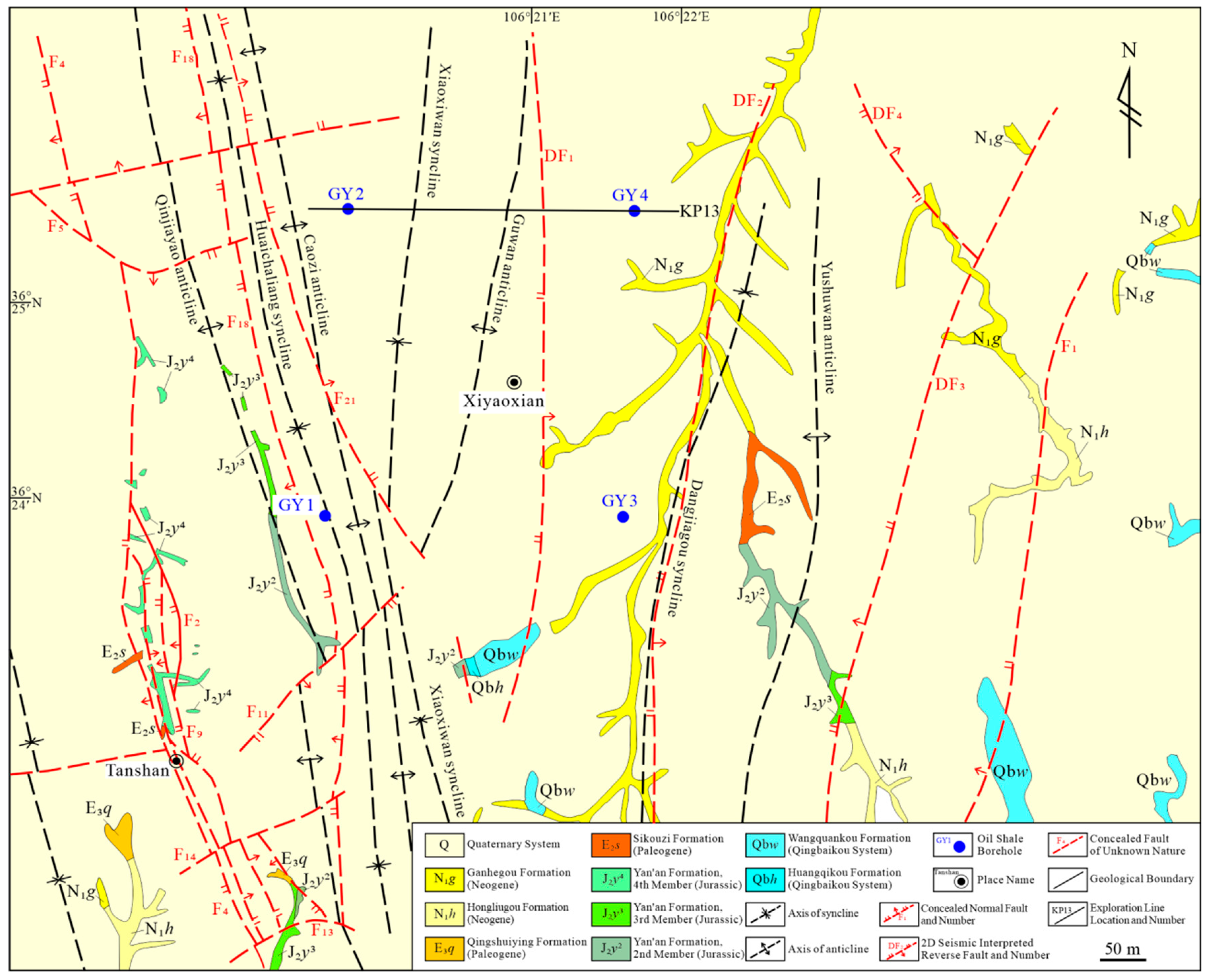
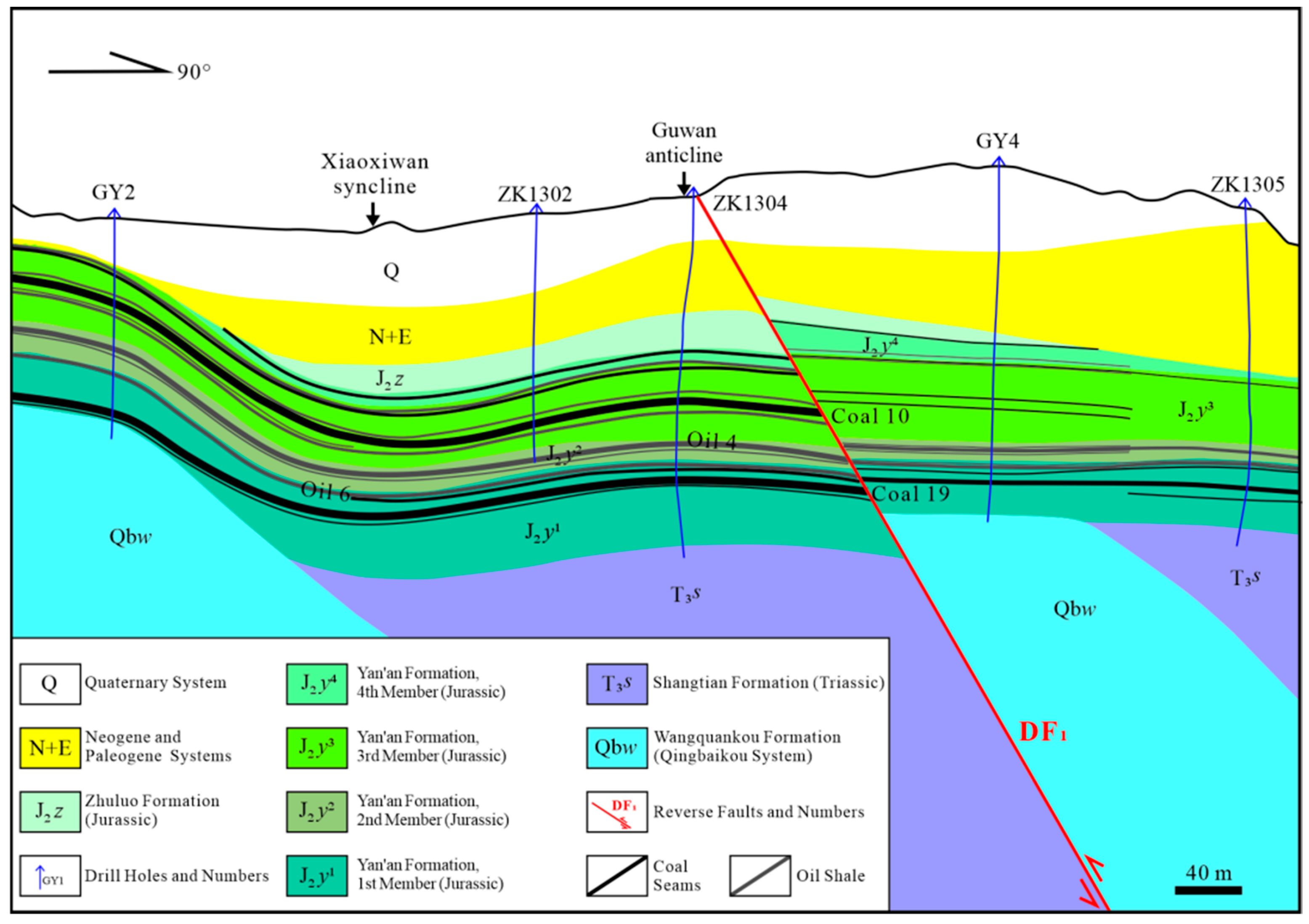
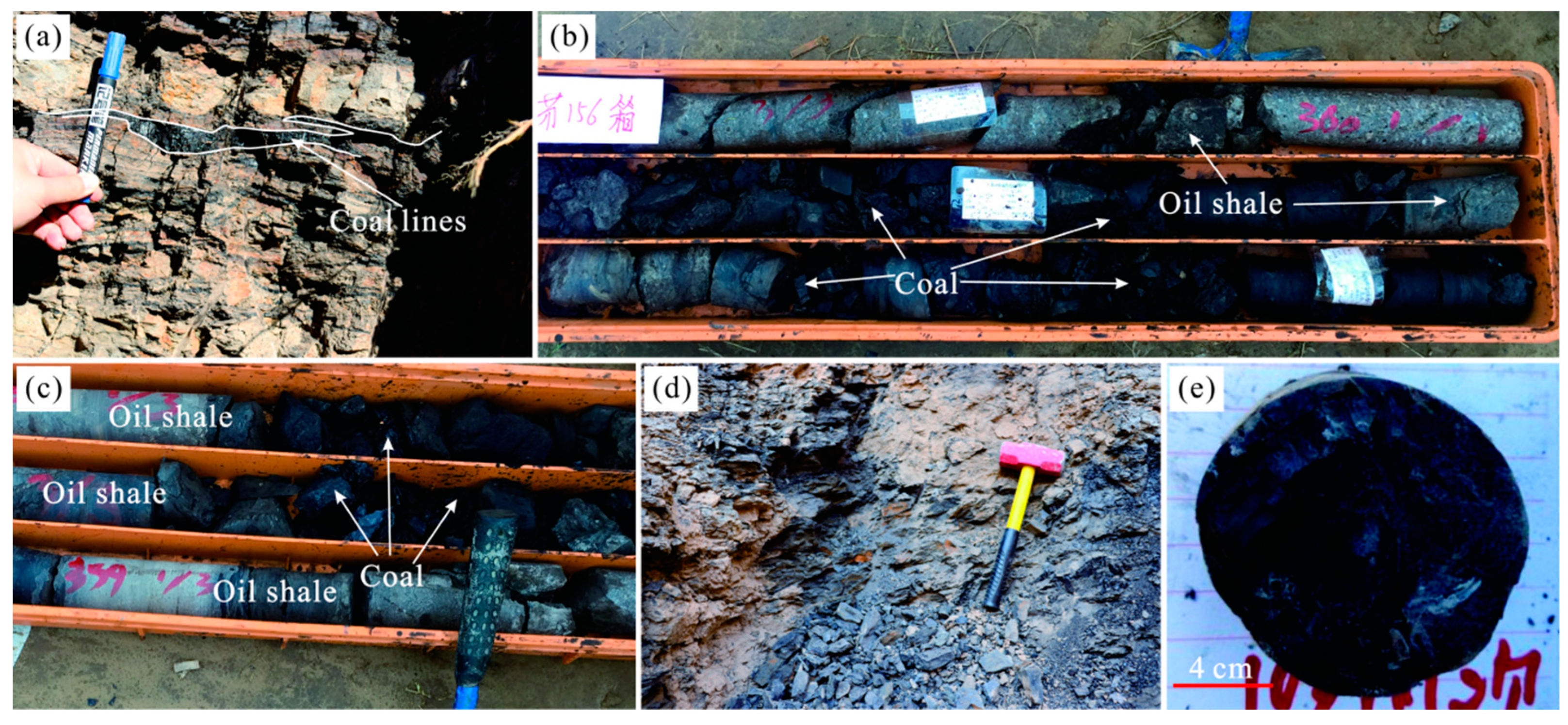
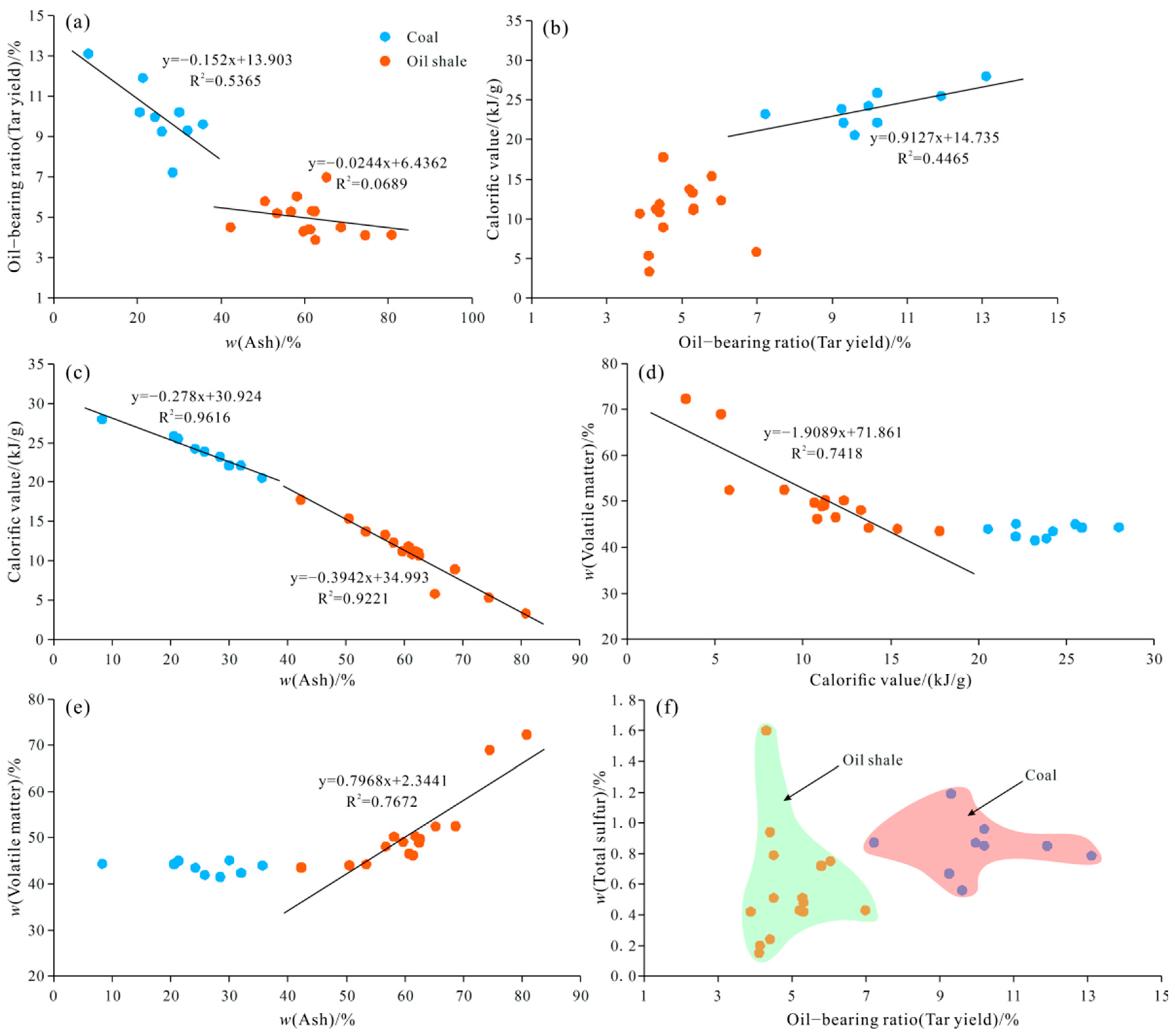


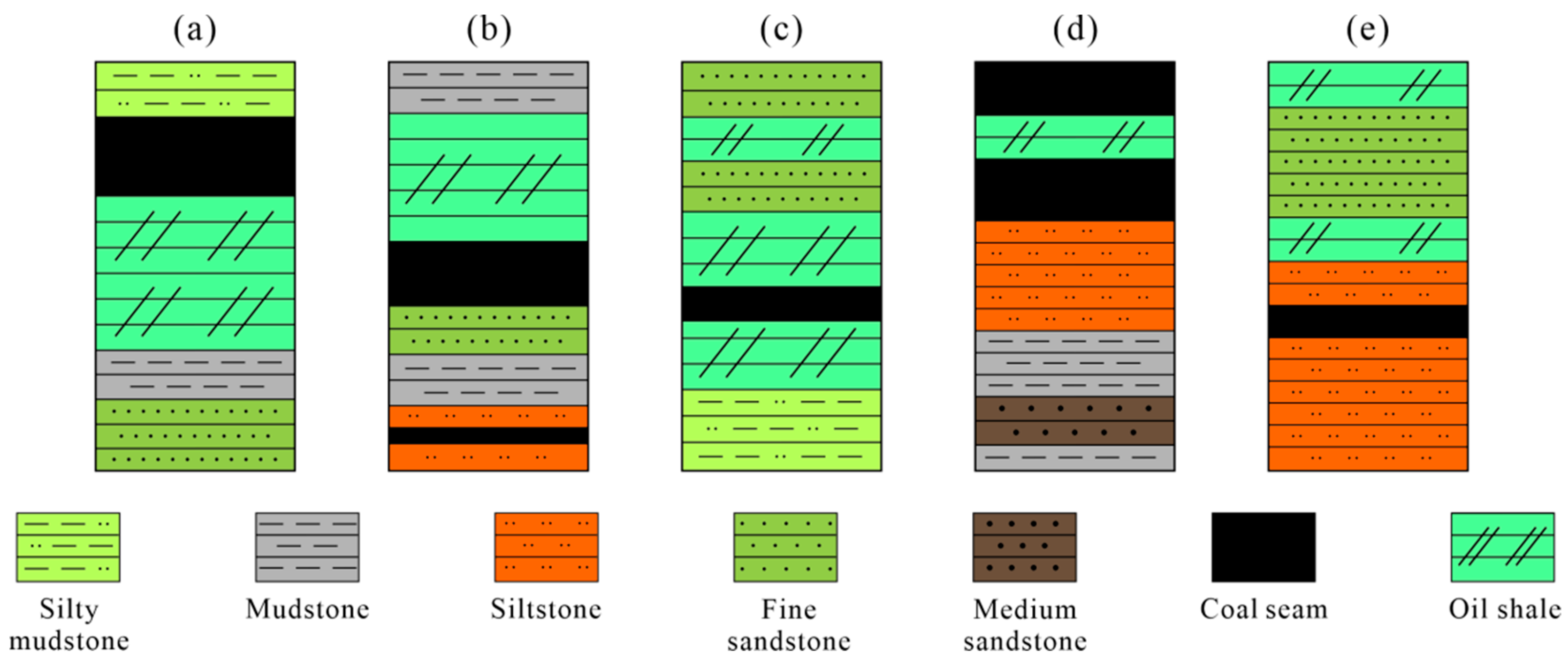

| Formation | Average Formation Thickness/m | Average Coal Seam Thickness/m | Average Minable Coal Seam Thickness/m | Coal Seam Coefficient/% | Minable Coal Seam Coefficient/% | Reservoir Number |
|---|---|---|---|---|---|---|
| J2y4 | 31.75 | 1.81 | - | 5.70 | - | coal 2, |
| J2y3 | 117.78 | 8.14 | 5.47 | 6.91 | 4.64 | coal 6, coal 8, coal 10, coal 11, coal 12 |
| J2y2 | 85.30 | 3.66 | 3.84 | 4.29 | 4.50 | coal 14, coal 15 |
| J2y1 | 160.79 | 13.07 | 8.52 | 8.51 | 5.30 | coal 16, coal 17, coal 18, coal 19, coal 21, coal 22, coal 23, coal 24 |
| Serial Number | Formation | Reservoir Number | Depth/m | Oil-Bearing Ratio/% | Ash/% | Calorific Value/(kJ/g) | Total Sulfur/% | Volatile Matter/% |
|---|---|---|---|---|---|---|---|---|
| 1 | J2y4 | oil 1 | 1.10 | 4.50 | 42.28 | 17.77 | 0.51 | 43.55 |
| 2 | J2y3 | oil 2-1 | 0.86 | 4.11 | 74.49 | 5.33 | 0.15 | 68.97 |
| 3 | oil 2 | 1.52 | 4.40 | 61.35 | 10.81 | 0.24 | 46.18 | |
| 4 | oil 3-1 | 1.29 | 4.13 | 80.79 | 3.33 | 0.20 | 72.32 | |
| 5 | oil 3 | 1.36 | 6.98 | 65.23 | 5.81 | 0.43 | 52.47 | |
| 6 | oil 3-2 | 0.93 | 3.88 | 62.55 | 10.66 | 0.42 | 49.72 | |
| 7 | oil 3-3 | 1.55 | 4.50 | 68.67 | 8.93 | 0.79 | 52.52 | |
| 8 | J2y2 | oil 4-1 | 0.70 | 5.30 | 62.40 | 11.07 | 0.42 | 48.91 |
| 9 | oil 4 | 2.32 | 5.31 | 61.76 | 11.26 | 0.48 | 50.33 | |
| 10 | oil 4-2 | 0.77 | 4.40 | 60.73 | 11.86 | 0.94 | 46.52 | |
| 11 | oil 5 | 1.56 | 6.04 | 58.13 | 12.33 | 0.75 | 50.22 | |
| 12 | J2y1 | oil 6-1 | 0.89 | 4.30 | 59.69 | 11.22 | 1.60 | 49.11 |
| 13 | oil 6 | 1.99 | 5.28 | 56.73 | 13.30 | 0.51 | 48.11 | |
| 14 | oil 7 | 1.14 | 5.79 | 50.49 | 15.37 | 0.72 | 44.01 | |
| 15 | oil 8 | 0.78 | 5.20 | 53.41 | 13.74 | 0.43 | 44.23 | |
| Total/Average | 18.76(Total) | 4.94 | 61.25 | 10.85 | 0.57 | 51.14 | ||
| Serial Number | Seam Number | Tar Yield/% | Ash/% | Calorific Value/(kJ/g) | Total Sulfur/% | Volatile Matter/% |
|---|---|---|---|---|---|---|
| 1 | coal 6 | 10.20 | 30.01 | 22.13 | 0.96 | 45.11 |
| 2 | coal 10 | 11.90 | 21.28 | 25.50 | 0.85 | 45.02 |
| 3 | coal 11 | 13.10 | 8.25 | 27.99 | 0.79 | 44.37 |
| 4 | coal 12 | 9.97 | 24.17 | 24.23 | 0.87 | 43.48 |
| 5 | coal 14 | 10.20 | 20.55 | 25.88 | 0.85 | 44.30 |
| 6 | coal 16 | 9.60 | 35.66 | 20.53 | 0.56 | 44.00 |
| 7 | coal 17 | 9.30 | 32.01 | 22.11 | 1.19 | 42.34 |
| 8 | coal 19 | 7.22 | 28.45 | 23.21 | 0.87 | 41.50 |
| 9 | coal 21 | 9.25 | 25.81 | 23.86 | 0.67 | 41.91 |
| Average value | 10.08 | 25.13 | 23.94 | 0.85 | 43.56 | |
| Sample Number | Sample Name | Mineral Content/% | ||||||||||
|---|---|---|---|---|---|---|---|---|---|---|---|---|
| Quartz | K-Feldspar | Plagioclase | Calcite | Dolomite | Siderite | Magnesite | Pyrite | Hematite | Analcime | Clay Minerals | ||
| TY-1 | oil shale | 26.4 | 1.4 | 1.0 | 0.1 | - | - | 0.4 | 2.2 | - | 5.0 | 63.6 |
| TY-2 | oil shale | 46.7 | 2.7 | 1.3 | - | 0.8 | 0.6 | - | - | - | - | 47.9 |
| TY-3 | oil shale | 51.1 | 2.3 | 1.5 | - | - | 11.6 | - | - | - | - | 33.5 |
| TY-4 | oil shale | 52.1 | 1.9 | 0.9 | - | 0.5 | 1.2 | - | - | - | - | 43.3 |
| Average | 44.1 | 2.1 | 1.2 | - | - | - | - | - | - | - | 47.1 | |
| TM-1 | coal | 29.6 | 2.2 | - | 0.8 | - | - | - | - | 1.5 | - | 65.9 |
| TM-2 | coal | 32.9 | - | 1.3 | - | - | 0.4 | - | 0.4 | - | - | 64.9 |
| Average | 31.3 | 2.2 | 1.3 | - | - | - | - | - | - | - | 65.4 | |
| Ore Vein Serial Number | GY1 | GY2 | GY3 | GY4 | ||||
|---|---|---|---|---|---|---|---|---|
| Topographic Lithology | Base Surface Lithology | Topographic Lithology | Base Surface Lithology | Topographic Lithology | Base Surface Lithology | Topographic Lithology | Base Surface Lithology | |
| Oil 1 | / | / | / | / | / | / | carbonaceous mudstone (geology) | siltstone |
| Oil 2-1 | / | / | shale | shale | / | / | coal 6 | siltstone |
| Oil 2 | / | / | shale | siltstone | / | / | / | / |
| Oil 3-1 | / | / | siltstone | siltstone | siltstone | coal 12 | / | / |
| Oil 3 | / | / | shale | siltstone | coal 12 | coal 12 | / | / |
| Oil 3-2 | / | / | / | / | siltstone | siltstone | / | / |
| Oil 3-3 | / | / | / | / | siltstone | siltstone | / | / |
| Oil 4-1 | / | / | / | / | / | / | siltstone | coal seam (line) |
| Oil 4 | coal 14 | shale | coal 14 | siltstone | shale | coal 14 | shale | siltstone |
| Oil 4-2 | shale | siltstone | / | / | / | / | / | / |
| Oil 5 | / | / | siltstone | siltstone | / | / | shale | shale |
| Oil 6-1 | / | / | / | / | / | / | siltstone | siltstone |
| Oil 6 | siltstone | siltstone | siltstone | shale | coal 16 | shale | siltstone | siltstone |
| Oil 7 | shale | shale | / | / | siltstone | siltstone | / | / |
| Oil 8 | / | / | shale | conglomerates | / | / | / | / |
Disclaimer/Publisher’s Note: The statements, opinions and data contained in all publications are solely those of the individual author(s) and contributor(s) and not of MDPI and/or the editor(s). MDPI and/or the editor(s) disclaim responsibility for any injury to people or property resulting from any ideas, methods, instructions or products referred to in the content. |
© 2025 by the authors. Licensee MDPI, Basel, Switzerland. This article is an open access article distributed under the terms and conditions of the Creative Commons Attribution (CC BY) license (https://creativecommons.org/licenses/by/4.0/).
Share and Cite
Mu, C.; Yang, R.; Hai, L.; Xu, Q.; Yang, J.; Mei, C. Basis of Identification, Type of Syngenetic Assemblage, and Pattern of Development of Coal and Oil Shale in the Tanshan Area of the Eastern Liupanshan Basin, China. Energies 2025, 18, 2560. https://doi.org/10.3390/en18102560
Mu C, Yang R, Hai L, Xu Q, Yang J, Mei C. Basis of Identification, Type of Syngenetic Assemblage, and Pattern of Development of Coal and Oil Shale in the Tanshan Area of the Eastern Liupanshan Basin, China. Energies. 2025; 18(10):2560. https://doi.org/10.3390/en18102560
Chicago/Turabian StyleMu, Caixia, Rui Yang, Lianfu Hai, Qinghai Xu, Jun Yang, and Chao Mei. 2025. "Basis of Identification, Type of Syngenetic Assemblage, and Pattern of Development of Coal and Oil Shale in the Tanshan Area of the Eastern Liupanshan Basin, China" Energies 18, no. 10: 2560. https://doi.org/10.3390/en18102560
APA StyleMu, C., Yang, R., Hai, L., Xu, Q., Yang, J., & Mei, C. (2025). Basis of Identification, Type of Syngenetic Assemblage, and Pattern of Development of Coal and Oil Shale in the Tanshan Area of the Eastern Liupanshan Basin, China. Energies, 18(10), 2560. https://doi.org/10.3390/en18102560







